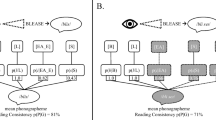Abstract
This paper addresses the issues with current systems of categorisation and measurement of linguistic metaphoricity, which have coloured most research into the area to-date. The paper discusses the role of metaphor as a form of creative language and a deviation from more linguistic norms and conventionalities. Two current theories are discussed as providing alternatives to metaphor identification approaches. These are Hanks’ (Int J Lexicogr 17:3, 2004) Theory of Norms and Exploitations and Hoey’s (Lexical priming and the properties of text, 2003) Theory of Lexical Priming. It is proposed that the theory of lexical priming can be adopted to provide an explanation of linguistic norms and exploitations involved in metaphoric language. Finally, the paper provides a brief corpus analysis of the verb to kindle found in a corpus of Nineteenth Century writings. The analysis will focus upon evidence of linguistic and secondary meaning primings within concordance lines.





Similar content being viewed by others
Notes
‘Application of a term to a thing which it does not properly denote; abuse or perversion of a trope or metaphor’ (http://www.oed.com/view/Entry/28665?redirectedFrom=catachresis#eid) —Accessed 29/04/2013.
For all concordance lines, see “Appendix”.
The obscure name comes from a relevant scene in the 1980 film Airplane!
References
Black, M. (1962). Models & metaphors: Studies in language & philosophy. New York: Cornell University Press.
Bickerton, D. (1969). Prolegomena to a linguistic theory of metaphor. Foundations of Language, 5, 34–52.
Carter, R. (2004). Language and creativity: The art of common talk. London: Routledge.
Charteris-Black, Jonathan. (2014). Analysing political speeches: Rhetoric, discourse and metaphor. London: Palgrave-Macmillan.
Declercq, C., & Le Ny, J.-F. (2008). Verb-patient co-occurrences in texts and verb meaning in memory. Journal of Pragmatics, 40, 630–645.
Deignan, A. (2005). Metaphor and corpus linguistics. Amsterdam: John Benjamins.
Firth, J. R. (1951). Modes of meanings. Reprinted in Papers in Linguistics 1934–1951 (pp. 190–215). London: Oxford University Press.
Gibbs, R. W, Jr. (1994). The poetics of mind. Cambridge: Cambridge University Press.
Giora, R. (2003). On our mind: Salience, context and figurative language. Oxford: Oxford University Press.
Goatly, A. (1997). The language of metaphors. London: Routledge.
Halliday, M. A. K. (1971). Language in a social perspective, the context of language (Educational Review, University of Birmingham. 23.3, pp. 165–188).
Hanks, P. (2004). The syntagmatics of metaphor. International Journal of Lexicography, 17, 3.
Hanks, P. (Ed.). (2008). Lexicology: Critical concepts in linguistics. London: Routledge.
Hanks, P. (2013). Lexical analysis. London: John Benjamins.
Hoey, M. (2003). Lexical priming and the properties of text. http://www.monabaker.com/tsresources/LexicalPrimingandthePropertiesofText.htm—Accessed on 24 July 2013.
Hoey, M. (2005). Lexical priming. London: Routledge.
Lakoff, G., & Johnson, M. (1980). Metaphors we live by. Chicago: University of Chicago Press.
Leech, G. (1969). A linguistic guide to english poetry. London: Longman.
Leech, G. (2008). Language in literature: Style and foregrounding. London: Pearson Longman.
Levin, S. R. (1977). The semantics of metaphor. Baltimore: London, John Hopkins University Press.
Louw, B. (2000). Contextual prosodic theory: Bringing semantic prosodies to life. In Chris Heffer & Helen Saunston (Eds.), Words in context: A tribute to John Sinclair on his retirement, english language research discourse analysis monograph 18. Birmingham: University of Birmingham.
Nowottny, W. (1965). Language poets use. London: Continuum.
OED: http://www.oed.com/view/Entry/221386?rskey=mr7GXe&result=2#eid (Accessed 26 April 2013)
Ortony, A. (Ed.). (1979). Metaphor and thought. Cambridge: Cambridge University Press.
Partington, A. (2006). Metaphors, motifs and similes across discourse types: Corpus-assisted discourse studies (CADS) at work. In A. Stefanowitsch & S. Gries (Eds.), Corpus-based approaches to metaphor and metonymy (pp. 267–304). Berlin: Mouton de Gruyter.
Philip, G. (2011). Colouring meaning: Collocation and connotation in figurative language. Amsterdam: John Benjamins.
Pragglejaz Group. (2007). MIP: A method for identifying metaphorically used words in discourse. Metaphor and Symbol, 22(1), 1–39.
Scott, M. (2005). Wordsmith tools, version 5 [Computer software]. Oxford: Oxford University Press.
Short, M. (1996). Exploring the language of poems, plays and prose. London: Longman.
Sinclair, J. (1991). Corpus, concordance, collocation. Oxford: Oxford University Press.
Steen, G. (2007). Finding metaphor in grammar and usage. Amsterdam: John Benjamins.
Steen, G., Dorst, A., Herrmann, B., Kaal, A., Krennmayr, T., & Pasma, T. (2010). A method for linguistic metaphor identification: From MIP to MIPVU, Amsterdam/Philadelphia.
Author information
Authors and Affiliations
Corresponding author
Appendix
Appendix
List of kindle concordances in corpus of 19th century writings:




Rights and permissions
About this article
Cite this article
Patterson, K.J. The Analysis of Metaphor: To What Extent Can the Theory of Lexical Priming Help Our Understanding of Metaphor Usage and Comprehension?. J Psycholinguist Res 45, 237–258 (2016). https://doi.org/10.1007/s10936-014-9343-1
Published:
Issue Date:
DOI: https://doi.org/10.1007/s10936-014-9343-1




